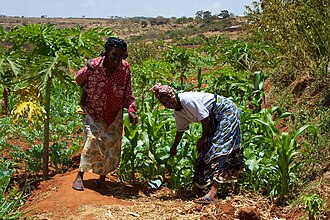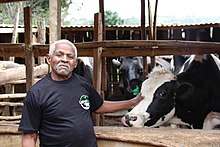begin quote from:
Smallholding
A smallholding or smallholder is a small farm operating under a small-scale agriculture model.[1] Definitions vary widely for what constitutes a smallholder or small-scale farm, including factors such as size, food production technique or technology, involvement of family in labor and economic impact.[2] Smallholdings are usually farms supporting a single family with a mixture of cash crops and subsistence farming. As a country becomes more affluent, smallholdings may not be self-sufficient, but may be valued for the rural lifestyle. As the sustainable food and local food movements grow in affluent countries, some of these smallholdings are gaining increased economic viability. There are an estimated 500 million smallholder farms in developing countries of the world alone, supporting almost two billion people.[3][4]
Small-scale agriculture is often in tension with industrial agriculture, which finds efficiencies by increasing outputs, monoculture, consolidating land under big agricultural operations, and economies of scale. Certain labor-intensive cash-crops, such as cocoa production in Ghana or Côte d'Ivoire, rely heavily on small holders; globally, as of 2008 90% of cocoa is grown by smallholders.[5] These farmers rely on cocoa for up to 60 to 90 per cent of their income. [6]Similar trends in supply chains exist in other crops like coffee, palm oil, and bananas.[7] In other markets, small scale agriculture can increase food system investment in small holders improving food security. Today some companies try to include smallholdings into their value chain, providing seed, feed or fertilizer to improve production. [8]
Because smallholding farms frequently require less industrial inputs and can be an important way to improve food security and sustainable food systems in less-developed contexts, addressing the productivity and financial sustainability of small holders is an international development priority and measured by indicator 2.3 of Sustainable Development Goal 2.[9][2] Additionally, since agriculture has such large impacts on climate change, Project Drawdown described "Sustainable Intensification for Smallholders" an important method for climate change mitigation.[10]
Issues[edit]
Productivity[edit]
| Agriculture |
|---|
 |
According to conventional theory, economies of scale allows agricultural productivity, in terms of inputs versus outputs, to rise as the size of the farm rises. Specialisation has also been a major factor in increasing agricultural productivity, for example as commodity processing began to move off the farm in the 19th century, farmers could spend more effort in primary food production.[11]
Although numerous studies show that larger farms are more productive than smaller ones,[12] some writers state that whilst conventional farming creates a high output per worker, some small-scale, sustainable, polyculture farmers can produce more food per acre of land.[13]
Small farms have some economic advantages. Farmers support the local economy of their communities. An American study showed that small farms with incomes of $100,000 or less spend almost 95 percent of their farm-related expenses within their local communities. The same study took in comparison the fact that farms with incomes greater than $900,000 spend less than 20 percent of their farm-related expenses in the local economy.[14]
Small-scale agriculture often sell products directly to the consumers. Disintermediation gives the farmer the profit that would otherwise go to the wholesaler, the distributor and the supermarket. About two thirds of the selling price would actually be lost for product marketing. If farmers sell their products directly to consumers, they receive a higher percentage of the retail price, although they will spend more time selling the same amounts of product, which is an opportunity cost.
Food security[edit]
Because smallholding farms frequently require less industrial inputs and can be an important way to improve food security in less-developed contexts, addressing the productivity and financial sustainability of small holders is an international development priority and measured by indicator 2.3 of Sustainable Development Goal 2.[9][2] The International Fund for Agricultural Development has an ongoing program for Adaptation for Smallholder Agriculture.[15]
During the global COVID-19 pandemic, and the attendant disruptions of food systems, their role has become more important.[16]
Environmental and climate adaptation[edit]
While historical focus on smallholders has been increasing global food supply under climate change and the role played by smallholder communities, climate adaptation efforts are still hindered by lack of information on how smallholder farmers are experiencing and responding to climate change. There is lack of detailed, context-specific information on what climate change portends to smallholder farmers in different and widely varying agroecological environments and socio-economic realities, and what management strategies they are employing to deal with these impacts.[17][18]
Especially for smallholders working in commodity crops, climate change introduces an increasing amount of variability to farmer economic viability; for example, Coffee production globally is under increased threat, and smallholders in East Africa, such as in the Ugandan, Tanzanian or Kenyan industries, are rapidly losing both viable coffee land and productivity of plants.[19]
In some cases, smallholders are an important source of deforestation. For example, smallholders are an important component of the oil palm industry of Southeast Asia, contributing 40% of the production. Because such farmers are less able to access financing than larger businesses, they are unable to fund methods to increase the productivity of their farms when yields decline, increasing their need to clear more land.[20] Increasing productivity, especially amongst smallholder farms, is an important way to decrease the amount of land needed for farming and slow environmental degradation through processes like deforestation.[10][20]
Commonwealth countries[edit]
Smallholdings in Britain[edit]
In British English usage, a smallholding is a piece of land and its adjacent living quarters for the smallholder and stabling for farm animals. It is usually smaller than a farm but larger than an allotment, usually under 50 acres (20 ha). It is often established for breeding farm animals organically on free-range pastures. Alternatively, the smallholder may concentrate on growing vegetables by traditional methods or, in a more modern way, using plastic covers, polytunneling or cloches for quick growth.
Generally, a smallholding offers its owner a means of achieving self-sufficiency for its family's needs. They may be able to supplement their income by selling surplus produce at a farmers' market or at a permanent shop on the smallholding.
Hobby farms in Australia[edit]
In Western Australia, many small acre farms were established under the Agricultural Land Purchase Act to encourage settlement. The government purchased large land grants held by absentee owners and subdivided them according to the best use for the land: the development of orchids in Coondle, viticulture, horse breeding, sheep grazing, and high density crops like corn, and broad acre crops like wheat.
A hobby farm in Australia is a variety of smallholding that may be as small as 2 hectares up to a self-sustaining farm size, that allows the "city farmer" to have a house and a small number of animals or small crop fields or grape vines. In Western Australia, they are often termed Special Rural Properties for planning purposes.
Lifestyle blocks in New Zealand[edit]
In New Zealand, a lifestyle block is a smallholding valued primarily for the rural lifestyle it affords. Planning restrictions on subdividing farm land often lead to the creation of lifestyle blocks of minimum permissible size near urban areas.
Developing countries[edit]
In many developing countries, smallholding is a small plot of land with low rental value, used to grow crops.[21] By some estimates, there are 525 million smallholder farmers in the world.[22] These farms vary in land sizes, production and labor intensities.[23] The distribution of farm sizes depends on a number of agroecological and demographic conditions, as well as on economic and technological factors.[24] Smallholders are critical to local and regional food systems, as well as livelihoods, and especially so during periods of food supply chain disruptions.[25] Smallholders dominate production in certain key sectors such as coffee and cocoa. Various types of agribusinesses enterprises work with smallholding farmers in a range of roles including buying crops, providing seed, and acting as financial institutions.[26]
In low-income countries, women make up 43 percent of small holding agricultural labor, but produce 60–80 percent of food crops.[10]
India[edit]
In India there is a five sizes classification for small holders. These are 'marginal' less than 1ha, 'small' between 1 and 2ha, 'semi-medium' between 2 and 4ha, 'medium' between 4 and 10 ha, 'large' above 10ha. If we use 4ha (marginal + small + medium) as a threshold, 94.3% holdings are small and these constitute 65.2% of all farmland.[4] The bulk of India's hungry and poor people are constituted of small holder farmers and landless people. 78% country’s farmers own less than 2ha, which constitutes 33% of total farmland but at the same time they produce 41% of country’s food grains. 20% of world's poor live in India, although country was self sufficient in food production in 2002 due to first Green Revolution started in later half of twentieth century, numerous households lacked resources to purchase food. Holdings less than 2ha contributed 41% of total food grain production in 1991 compared to 28% in 1971, which means a substantial increase, whereas medium holdings registered mere 3% increase in same period and large holdings registered a decline from 51 to 35%. This signifies the importance of small holders in the Green Revolution and the attainment of national food security. Small holder families are becoming more vulnerable and more disadvantaged due to expansion of international trade liberalisation. Needs and aspirations of small farmers must feature prominently in policies of market reform that seek to improve food and nutritional security. India's total increase rate of productivity across the farming sector was far less in 1990's when compared to previous decades.[27]
Kenya[edit]
Kenya's smallholder production accounts for 78 percent of total agricultural production and 70 percent of commercial production.[28] Majority of the smallholder population work in farm sizes averaging 0.47 hectares.[29] This represents the vast majority of Kenya's rural poor population who depend on agriculture for their livelihood.[30] Adverse risk events during the period 1980–2012
led to production losses in smallholder farms resulting in a drop in agricultural gross domestic product (GDP) of 2 percent or more.[30] Increasing the productivity of smallholder farmers is encouraged due to its potential of improving food availability, increasing rural incomes, lowering poverty rates, and growing the economy.[30] Diversification of crops in smallholder farms is one of the potential strategies in sustaining agricultural productivity, and copping with marketing risks.[31] It is also a transitional step from subsistence to commercial agriculture.[citation needed] Age, education of household head, type of crops, cropping system, amount of credit, and irrigation facilities are some of the factors influencing diversification in smallholder farms.[32]
Tanzania[edit]
Along the upper and middle reaches of the Nduruma River in the Pangani River Basin, Tanzania, there is not enough water to go around. Smallholder farmers address inequities in land and water distribution by enforcing existing traditional local rules. Whilst larger estate farms may have governmental licences guaranteeing rights to the water, a study found that those large-scale farms which adhere to the traditional water rights structures fare better in terms of social reputation, which better ensures their access to water. Adhering to the water law in order to enforce their permits is less effective, as regional Tanzanian local governments generally attempt to avoid conflict with their populace. On a larger scale, however, existing traditional rules are ineffective in maintaining cooperation among users along the Nduruma River.[33]
Thailand[edit]
In 1975, there were 4.2 million smallholder farming households in Thailand. In 2013, Thailand had 5.9 million smallholder farming households. The average area of these smallholdings had shrunk from 3.7 hectares to 3.2 hectares over that period. Instead of farms getting larger and less numerous, as has been the case in the Global North, the reverse happened: they got smaller and more numerous.[34]
See also[edit]
- Allotment (gardening)
- Asset-based community development
- Building-integrated agriculture
- Ecological sanitation
- Foodscaping
- Forest gardening
- Green wall
- Growbag
- Growroom
- Guerrilla gardening
- Intercultural garden
- Market garden
- Permaculture
- Rooftop gardens
- Satoyama
- Sheet mulching
- Subsistence agriculture
- Terraces (agriculture)
- Underground farming
- Urban agriculture
- Urban horticulture
- Urban forestry
- Vertical farming
- Window box
- Windowfarm


No comments:
Post a Comment